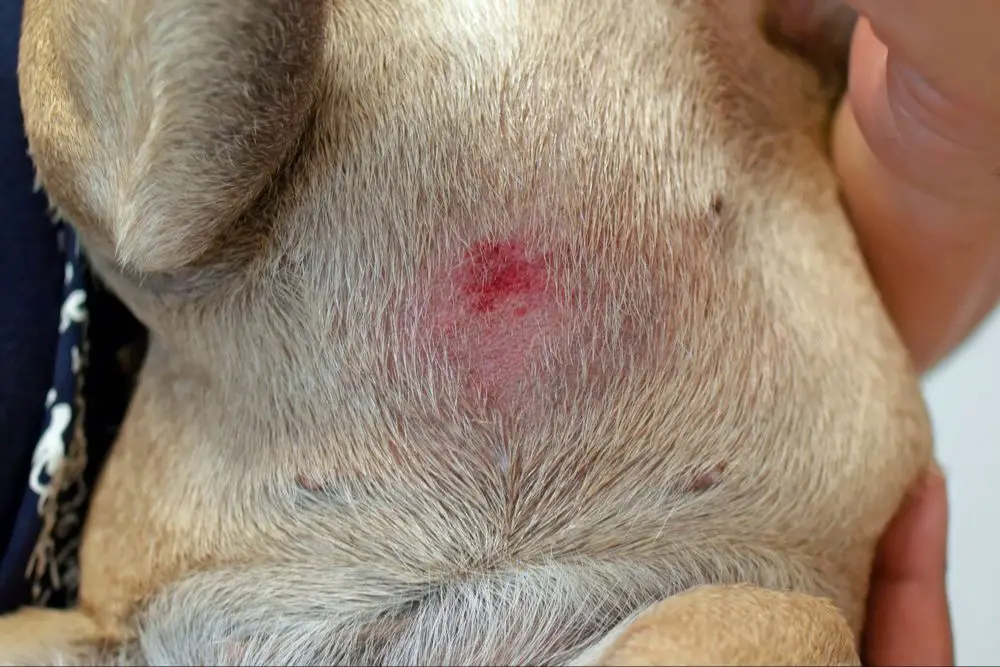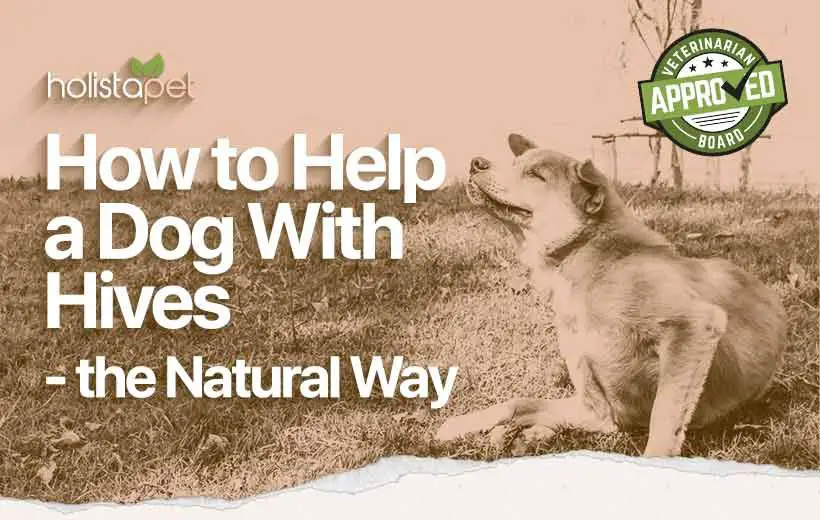What are Hives in Dogs?
Hives, also known as welts or wheals, are red, raised, itchy bumps on a dog’s skin that appear as an allergic reaction. Hives are caused by the release of histamine in the skin, which causes localized swelling, redness, and itching. They can range in size from a few millimeters to the size of a dinner plate. Hives can occur over just small parts of a dog’s body or spread to cover the entire body.

Hives are typically benign, but can sometimes indicate a more serious allergic reaction. Mild hives may go away on their own, while severe cases of hives that cover large surface areas are considered an emergency. Hives caused by an allergic reaction can come and go quickly, with new welts appearing as old ones fade. Recurring hives are frustrating for dogs and their owners. Identifying the source is key to prevention and treatment.
Common Causes of Recurring Hives
There are several common triggers that can cause hives to keep recurring in dogs. Identifying the underlying cause is key to getting the problem under control.
Food allergies are a major culprit behind chronic hives in dogs. Some common food allergens include beef, dairy, chicken, eggs, corn and wheat. A dog with food allergies will break out in hives shortly after consuming the offending food. Keeping a food diary and eliminating ingredients one at a time can help identify the allergy.
Environmental allergens like dust, pollen or mold spores can also cause recurring hive outbreaks. Dogs may react to these allergens when they are inhaled or come in contact with the skin. Seasonal allergies to pollens are a common trigger of hives in the spring and fall.
Insect bites from fleas, mosquitoes or other bugs can cause an allergic reaction on the skin that leads to hives. These cases are more sporadic but may recur if the dog continues to get bitten.
Bacterial or fungal skin infections can also trigger hives in some dogs. The infection triggers an inflammatory response that manifests as hives. Once the underlying infection is treated, the hives should resolve.
Diagnosing the Underlying Cause

If your dog continues to have recurring hive flare-ups, it’s important for your veterinarian to do a thorough diagnostic workup to determine the underlying cause. This will involve:
– Reviewing your dog’s full medical history and timeline of symptoms. Your vet will ask detailed questions about when hives first appeared, how often they occur, what seems to trigger flare-ups, and your dog’s overall health.
– Conducting allergy testing. Skin or blood tests can check for allergies to environmental allergens like pollens or dust mites, as well as food allergies. This helps identify potential triggers to avoid.
– Performing diagnostic tests like skin scrapings or skin cultures. This looks for infectious organisms like mites, fungi or bacteria that could be provoking an allergic reaction.
– Doing skin biopsies to check for abnormal immune responses in the skin that may be causing hives.
Getting to the root cause is crucial for stopping the cycle of recurring hives in dogs. Your vet will determine which diagnostic steps are needed based on your individual dog’s situation and symptoms.
Treatment Options
There are several treatment options that can help manage recurring hives in dogs:
Antihistamines
Antihistamines like diphenhydramine (Benadryl) can help block the action of histamines and reduce itching and hives. It’s important to consult your vet on proper dosing based on your dog’s weight.
Steroids
Short-term use of oral steroids like prednisone may be prescribed to reduce inflammation and stop recurrent hives. Long-term use can have side effects, so steroids should be used judiciously under veterinary supervision.
Immunotherapy
Allergy shots can help desensitize your dog to whatever allergens are triggering the hives. A veterinary dermatologist can formulate a customized allergy serum to help the immune system tolerate the allergen.
Allergy Avoidance
If environmental allergies are the cause, keeping your dog away from the allergen can prevent recurrent flares. This may mean keeping them indoors during high pollen times or switching to a hypoallergenic dog food.
Managing Environmental Allergies
One of the most effective ways to manage environmental allergies is to limit your dog’s exposure to the suspected allergens as much as possible. This may involve keeping your dog indoors during peak pollen seasons or avoiding areas with irritants like cigarette smoke, perfumes, cleaning products or air fresheners. Investing in an air purifier with a HEPA filter can help reduce airborne allergens at home. Be sure to use allergen-proof bedding and wash your dog’s bedding weekly in hot water to kill dust mites. Vacuum and dust regularly using a vacuum with a HEPA filter, and consider investing in an air duct cleaning if mold, dust and dander tend to accumulate in your system. Pay close attention to your dog’s reactions and keep a log to identify problem areas or times of day when flare ups tend to occur. With some adjustments, you can make your home a more comfortable environment for a dog prone to environmental allergies.
Controlling Food Allergies
For dogs with recurrent hives caused by food allergies, adjusting the diet is critical for controlling flare-ups. There are several diet strategies that can help:

-
Novel Protein Diet Trial: Switching your dog to a protein source they have never eaten before, such as venison, kangaroo, or duck, can help identify food triggers. Feed a novel protein diet exclusively for 8-12 weeks to see if it reduces hive outbreaks.
-
Hydrolyzed Protein Foods: Hydrolyzed protein pet foods are broken down into small pieces so they are less likely to cause an allergic reaction. They can be a good option for dogs with multiple food allergies.
-
Avoiding Trigger Ingredients: If you’ve identified specific ingredients that seem to cause hives, avoid feeding any products containing those ingredients. Common triggers include chicken, beef, dairy, wheat, soy, eggs, and corn.
Working with your veterinarian, use an elimination diet trial to pinpoint problem ingredients. Then carefully control your dog’s diet to avoid hive-inducing foods.
Care During a Hive Flare-up
When your dog is experiencing a hive flare-up, there are some at-home remedies you can try to help soothe their itching and discomfort:
Cold compresses – Applying a cold, wet towel or cloth to the affected areas can help reduce inflammation and itching. Make sure the compress isn’t too cold and limit application to 10-15 minutes at a time.
Oatmeal baths – Baths with colloidal oatmeal can help moisturize, soothe, and calm itchy skin during a flare-up. Lukewarm water is best. Rinse your dog thoroughly after the oatmeal bath.
Avoid scratching – As hard as it may be, try to discourage your dog from scratching, licking, or biting the hives as this can worsen the reaction. Consider an Elizabethan collar to prevent scratching. Provide plenty of toys and distractions.
When to See the Vet
While mild hive flare-ups often resolve on their own, more severe reactions require veterinary care. Contact your vet immediately if your dog’s hives last more than 24 hours or are accompanied by concerning symptoms like:
-
Difficulty breathing – This may present as open-mouth breathing, gasping, wheezing, or other signs of respiratory distress.
-
Swelling of the face or throat – Facial swelling, enlarged tongue, and swollen muzzle or eyes indicate angioedema, which can obstruct breathing.
Anaphylaxis is a life-threatening allergic reaction that demands emergency vet care. Symptoms of anaphylaxis include pale gums, collapse, and a weak pulse in addition to facial swelling and breathing issues. Even if hives and swelling initially improve with antihistamines, rapid worsening can occur and needs immediate treatment.
See your vet promptly if hives cover large areas of your dog’s body or persist beyond 24 hours. Though not all cases require medication, your vet can provide stronger antihistamines, steroids, or other drugs to control severe hive reactions and determine if an underlying disorder is to blame.
Prevention of Future Flare-ups
For dogs prone to recurring hives, prevention is key. There are several steps you can take to minimize flare-ups:

Maintain allergen avoidance. If your dog has environmental or food allergies that trigger hives, be vigilant about limiting exposure to those allergens. Use air filters, wash bedding regularly, avoid going outside during high pollen times, and strictly feed the prescription or elimination diet recommended by your vet.
Follow prescription diet. If your vet prescribes a special hypoallergenic or hydrolyzed protein dog food, make sure to feed it exclusively. No treats, table food or flavored medications unless expressly approved by your vet. This will help prevent hives caused by food allergies.
Monitor skin and coat health. Check your dog’s skin and coat daily for signs of hives, rashes, redness, scratching, licking or itching. Catching flare-ups early allows for quicker treatment. Keeping skin and coat healthy with fatty acid supplements may also help prevent hives.
Outlook for Dogs with Recurring Hives
The outlook for dogs with recurring hives can be quite good with proper management and care. While hives may come and go throughout a dog’s life, the condition often responds well to treatment and preventative measures.
With determination of the underlying cause, whether it be food allergies, environmental allergies, or other triggers, recurrence of hives can frequently be avoided. Dogs with food allergies may need to stick to specialized diets long-term. For environmental allergies, limiting exposure to the allergen is key. Medications may be required daily or intermittently to control flare-ups.
While recurring hives cannot always be fully cured, the prognosis for bringing hives under control and minimizing outbreaks is positive when dog owners work closely with their veterinarian. With diligent management of triggers, medications as needed, and prompt care when flare-ups occur, dogs can often live happy and comfortable lives despite their tendency for hives.
While recurring hives present an annoyance and discomfort for dogs, the condition can generally be well-managed with the right prevention and treatment plan. With a veterinarian’s guidance and an owner willing to invest in their dog’s care and comfort, dogs prone to hives can still lead full, active lives.
